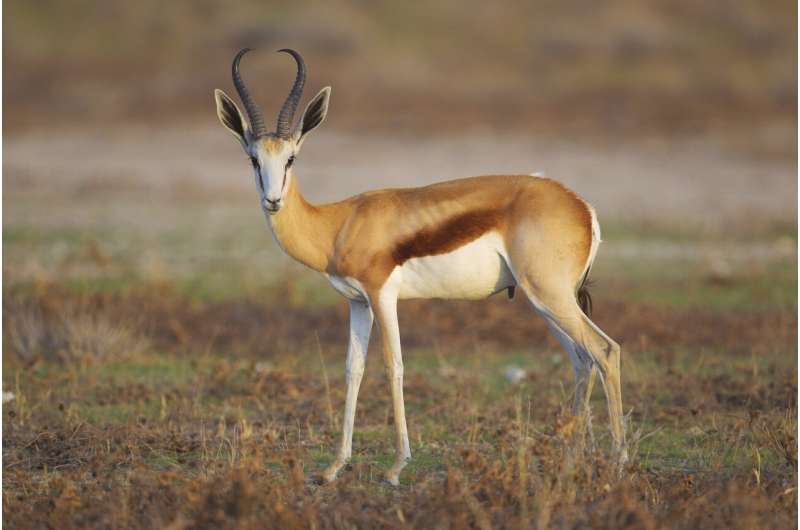This article has been reviewed according to Science X's editorial process and policies. Editors have highlighted the following attributes while ensuring the content's credibility:
fact-checked
peer-reviewed publication
trusted source
proofread
How antelopes under threat from the climate crisis have responded to rising temperatures

The climate crisis is turning the temperature up all over the world, but in southern Africa, the rise has been particularly concerning. Wild animals dependent on delicate ecosystems which are already dry, so that food and water scarcity limits their ability to cope with increased heat, are at serious risk. Scientists studied the behavior of three different species of antelope with overlapping ranges in Namibia to try to understand how animals of different sizes and behaviors adapt to the heat.
"Even the indigenous wildlife, adapted to hot and arid conditions, shows sensitivity to extreme heat," said Paul Berry of the University of Potsdam, lead author of the study in Frontiers in Ecology and Evolution. "We need to consider the possibility that additional anthropogenic influences such as habitat fragmentation may compound the effect of rising temperatures."
Tackling thermal stress
Animals can respond to high heat in several different ways, including genetic change, migration, and behavior changes, but the most flexible response is changing their behavior. Animals may move into cooler areas within their territories or change their posture, change their times of activity or the amount of activity they do, pant or decrease their energy intake. All these ways of countering heat stress impose physical costs and have limitations, but we can't understand the trade-offs without first understanding how animals use them.
The team studied three species of antelope: small springbok, medium-sized kudu, and large eland. Springbok prefer open habitats and are highly mobile, while kudu favor woodland and travel less. Eland are also relatively mobile, occurring in a broad range of habits, and like springbok they are largely independent of water provided that there is sufficient moisture in their food.
The scientists fitted adult animals with collars containing accelerometers that measured their movements in the hottest periods of the year between 2019 and 2021. They cross-referenced this data with measurements recorded by a local weather station and maps that track the temperatures across the different species' ranges.
Springbok most affected
The hotter temperatures affected springbok activity most. Increased heat led to a decline in activity, as they moved less during the day and did not compensate with more nighttime activity. Eland did shift their activity from daytime to nighttime, but were generally less affected, perhaps because they don't forage in open, exposed areas as much as springbok do. Kudu activity changed very little: they usually prefer the shade and are less mobile than either of the other species. Eland and kudu are also larger, and besides being less affected by predation risk because they are more difficult to hunt, may be able to absorb a greater heat rise before being seriously affected by thermal stress.
"While we showed how antelope differ in their response to extreme heat, it would be insightful to know also how they change their behavior," said Berry. "We intend to use machine learning models to classify behavior, such as feeding, resting, and movement, based on accelerometer data that has been mapped to behavior by direct observation."
The scientists also hypothesized that other animals' heat response could be similarly affected by these body size and habitat preference factors, but more research will be needed to determine this. As heat stress that isn't lethal can still affect the health and reproductive fitness of an animal population, the authors warned that increased heat stress could lead to changes in the ecosystem, with significant consequences for the local area.
"Managing the land both in an economically viable and an ecologically sustainable way is a complex task with far-reaching implications for the social and economic welfare of the region's inhabitants," said Dr. Niels Blaum of the University of Potsdam, senior author of the study. "Deepening our understanding of arid savanna ecosystems is therefore so important."
More information: Keeping cool on hot days: Activity responses of African antelope to heat extremes, Frontiers in Ecology and Evolution (2023). DOI: 10.3389/fevo.2023.1172303
Journal information: Frontiers in Ecology and Evolution
Provided by Frontiers


















